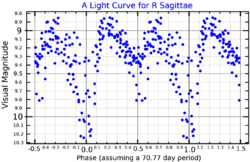Astronomy:R Sagittae
| Observation data Equinox J2000.0]] (ICRS) | |
|---|---|
| Constellation | Sagitta |
| Right ascension | 20h 14m 03.7451s[2] |
| Declination | +16° 43′ 35.053″[2] |
| Apparent magnitude (V) | 8.9-9.8[3] |
| Characteristics | |
| Evolutionary stage | Post-AGB |
| Spectral type | G0Ib-G8Ib[3] |
| U−B color index | +0.1-+0.9[4] |
| B−V color index | +0.75-+1.3[4] |
| Variable type | RVb[3] |
| Astrometry | |
| Radial velocity (Rv) | +8.3[5] km/s |
| Proper motion (μ) | RA: −2.180[6] mas/yr Dec.: −4.818[6] mas/yr |
| Parallax (π) | 0.4030 ± 0.0457[6] mas |
| Distance | approx. 8,100 ly (approx. 2,500 pc) |
| Absolute magnitude (MV) | –3.505[7] |
| Details | |
| Mass | 0.81[7] M☉ |
| Radius | 61.2+12.5 −9.9[7] R☉ |
| Luminosity | 2,329+744 −638[7] L☉ |
| Surface gravity (log g) | -0.5-0.0[3] cgs |
| Temperature | 5,100[7] (4,250-5,750[3]) K |
| Metallicity [Fe/H] | -0.50[3][8] dex |
| Other designations | |
| Database references | |
| SIMBAD | data |
R Sagittae is an RV Tauri variable star in the constellation Sagitta that varies from magnitude 8.0 to 10.5 in 70.77 days. It is a post-AGB low mass yellow supergiant that varies between spectral types G0Ib and G8Ib as it pulsates. Its variable star designation of "R" indicates that it was the first star discovered to be variable in the constellation. It was discovered in 1859 by Joseph Baxendell, though classified as a semi regular variable until RV Tauri variables were identified as a distinct class in 1905.[9]
R Sagittae is classified as an RV Tauri variable because of the distinctive regular variations with alternating deep and shallow minima. The period is conventionally quoted as the time between two deep minima and is the fundamental pulsation mode. The shallow minimum is the result of a first overtone pulsation. It is further classified as RVb since the average and maximum magnitude varies slowly over several years. The main period also varies over a period of decades.[4] It has around 90% the mass of the Sun and an average effective (surface) temperature of around 5000 K.[10] It is around 10,000 times as luminous as the Sun.[3] Measurement of its parallax by the Gaia satellite yields a distance of around 8,100 light-years.[6]
Variable star observer David Levy recommends that amateur observers monitor it once a week to observe changes in brightness.[11]
RV Tauri variables are post-AGB stars, originally similar to the Sun but now in the last stages of their lives. They are crossing the Cepheid instability strip as they lose their outer layers on the way to becoming a planetary nebula. Although their spectra and luminosities resemble supergiants, they are old low mass population II stars. A period-colour-luminosity relationship has been derived from observations of RV Tauri variables in the Large Magellanic Cloud that is closely related to the relationship for type II Cepheid variables.[12]
References
- ↑ "ASAS All Star Catalogue". The All Sky Automated Survey. http://www.astrouw.edu.pl/asas/?page=aasc.
- ↑ 2.0 2.1 Hog, E.; Kuzmin, A.; Bastian, U.; Fabricius, C.; Kuimov, K.; Lindegren, L.; Makarov, V. V.; Roeser, S. (1998). "The TYCHO Reference Catalogue". Astronomy and Astrophysics 335: L65. Bibcode: 1998A&A...335L..65H.
- ↑ 3.0 3.1 3.2 3.3 3.4 3.5 3.6 Gonzalez, Guillermo; Lambert, David L.; Giridhar, Sunetra (1997). "Abundance Analyses of the Field RV Tauri Variables: EP Lyrae, DY Orionis, AR Puppis, and R Sagittae". The Astrophysical Journal 479 (1): 427–440. doi:10.1086/303852. Bibcode: 1997ApJ...479..427G.
- ↑ 4.0 4.1 4.2 Zsoldos, E. (1993). "Photometry of yellow semiregular variables - AC Herculis, R Sagittae and V Vulpeculae". Astronomy and Astrophysics 268: 149. Bibcode: 1993A&A...268..149Z.
- ↑ Wilson, Ralph Elmer (1953). "General catalogue of stellar radial velocities". Washington: 0. Bibcode: 1953GCRV..C......0W.
- ↑ 6.0 6.1 6.2 6.3 Brown, A. G. A. (August 2018). "Gaia Data Release 2: Summary of the contents and survey properties". Astronomy & Astrophysics 616: A1. doi:10.1051/0004-6361/201833051. Bibcode: 2018A&A...616A...1G. Gaia DR2 record for this source at VizieR.
- ↑ 7.0 7.1 7.2 7.3 7.4 Bódi, A.; Kiss, L. L. (2019). "Physical properties of galactic RV Tauri stars from Gaia DR2 data". The Astrophysical Journal 872 (1): 60. doi:10.3847/1538-4357/aafc24. Bibcode: 2019ApJ...872...60B.
- ↑ Wahlgren, Glenn M. (1992). "The metallicity and luminosity of RV Tauri variables from medium-resolution spectra". Astronomical Journal 104: 1174. doi:10.1086/116306. Bibcode: 1992AJ....104.1174W.
- ↑ Gerasimovič, B.P. (1929). "Investigations of Semiregular Variables. VI. A General Study of RV Tauri Variables". Harvard College Observatory Circular 341: 1–15. Bibcode: 1929HarCi.341....1G.
- ↑ Stasińska, G.; Szczerba, R.; Schmidt, M.; Siódmiak, N. (2006). "Post-AGB stars as testbeds of nucleosynthesis in AGB stars". Astronomy and Astrophysics 450 (2): 701–714. doi:10.1051/0004-6361:20053553. Bibcode: 2006A&A...450..701S.
- ↑ Levy, David H. (1998). Observing Variable Stars: A Guide for the Beginner. Cambridge, United Kingdom: Cambridge University Press. pp. 152–53. ISBN 978-0-521-62755-9. https://books.google.com/books?id=5-O2cd937FMC&pg=PA152.
- ↑ Pollard, K. R.; Alcock, C.; Allsman, R. A.; Alves, D.; Axelrod, T. S.; Becker, A. C.; Bennett, D. P.; Cook, K. H. et al. (2000). "RV Tauri Stars and Type II Cepheids in the Magellanic Clouds -- Results from the MACHO Database". The Impact of Large-Scale Surveys on Pulsating Star Research 203: 89. Bibcode: 2000ASPC..203...89P.
 |


